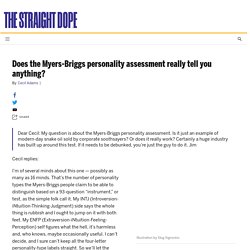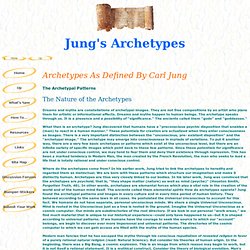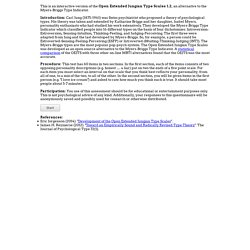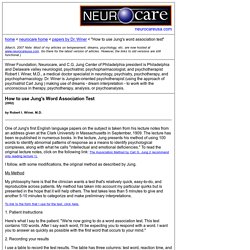

Nothing Personal: The questionable Myers-Briggs test. I was recently reviewing some psychological lectures for my real job.

One of these was on personality tests. The speaker mentioned the Myers-Briggs test, explaining that, while well known (I personally know it from a Dilbert cartoon) the Myers-Briggs test isn't recognised as being scientifically valid so is largely ignored by the field of psychology. I tweeted this fact, thinking it would be of passing interest to a few people. Have we all been duped by the Myers-Briggs test? Does the Myers-Briggs personality assessment really tell you anything? February 12, 2010 Dear Cecil: My question is about the Myers-Briggs personality assessment.

Is it just an example of modern-day snake oil sold by corporate soothsayers? Or does it really work? Certainly a huge industry has built up around this test. . — Jim Cecil replies: I’m of several minds about this one — possibly as many as 16 minds. First, an overview from the AK (Anal Know-it-all) Cecil: Nothing about the origin of the Myers-Briggs Type Indicator, or MBTI, inspires much confidence. My DL (Droning Lecturer) side continues: Myers and Briggs claimed their test could categorize people based on four either-or sets of characteristics, or dichotomies: Extraversion-Introversion, Sensing-iNtuition, Thinking-Feeling, and Judgment-Perception.
My CA (Cold-eyed Analyst) self thinks this is a dubious contention. My inner AD (Amiable Doofus) interjects: so what if MBTI categories aren’t as definitive as the Myers-Briggs people claim? — Cecil Adams NEW: THE STRAIGHT DOPE PODCAST! Kramer, Scott P. Personality test based on C. Jung and I. Briggs Myers type theory. MBTI Critique.
Jung's Archetypes. The Archetypal Patterns The Nature of the Archetypes Dreams and myths are constellations of archetypal images.

They are not free compositions by an artist who plans them for artistic or informational effects. Dreams and myths happen to human beings. The archetype speaks through us. What then is an archetype? Where do the archetypes come from? Modern man fancies that he has escaped the myths through his conscious repudiation of revealed religion in favor of a purely rational natural religion (read: Natural Science). The Archetypes The Shadow The most basic potential for patterning is the Shadow Archetype. The Shadow is the easiest of the archetypes for most persons to experience. The Shadow is the personification of that part of human, psychic possibility that we deny in ourselves and project onto others.
Jung Types Test. This is an interactive personality test using Carl Jungs's system of personality types as extended upon by Isabella Myers-Briggs.

The result you will receive will be similar to Myers-Briggs Type Indicator, of which this site has no affiliation. Introduction Carl Jung (1875-1961) was Swiss psychiatrist who proposed a theory of psychological types. His theory was taken and extended by Katharine Briggs and her daughter, Isabel Myers, personality enthusiasts who had studied his work extensively. They developed the Myers-Briggs Type Indicator which classified people into 16 different types on the basis of four dichotomies: Introversion-Extroversion, Sensing-Intuition, Thinking-Feeling, and Judging-Perceiving.
MBTI Information. How to use Jung's Word Association Test by Robert Winer, M.D. Neurology, Psychiatry, Psychopharmacology, Neuropsychiatry, and Psychotherapy. How to use Jung's Word Association Test (2002) by Robert I.

Winer, M.D. One of Jung's first English language papers on the subject is taken from his lecture notes from an address given at the Clark University in Massachusetts in September, 1909. The lecture has been re-published in numerous books. In the lecture, Jung presents his method of using 100 words to identify abnormal patterns of response as a means to identify psychological complexes, along with what he calls "intellectual and emotional deficiencies. " I follow, with some modifications, the original method as described by Jung. My Method My philosophy here is that the clinician wants a test that's relatively quick, easy-to-do, and reproducible across patients. To link to the form that I use for the test, click here.